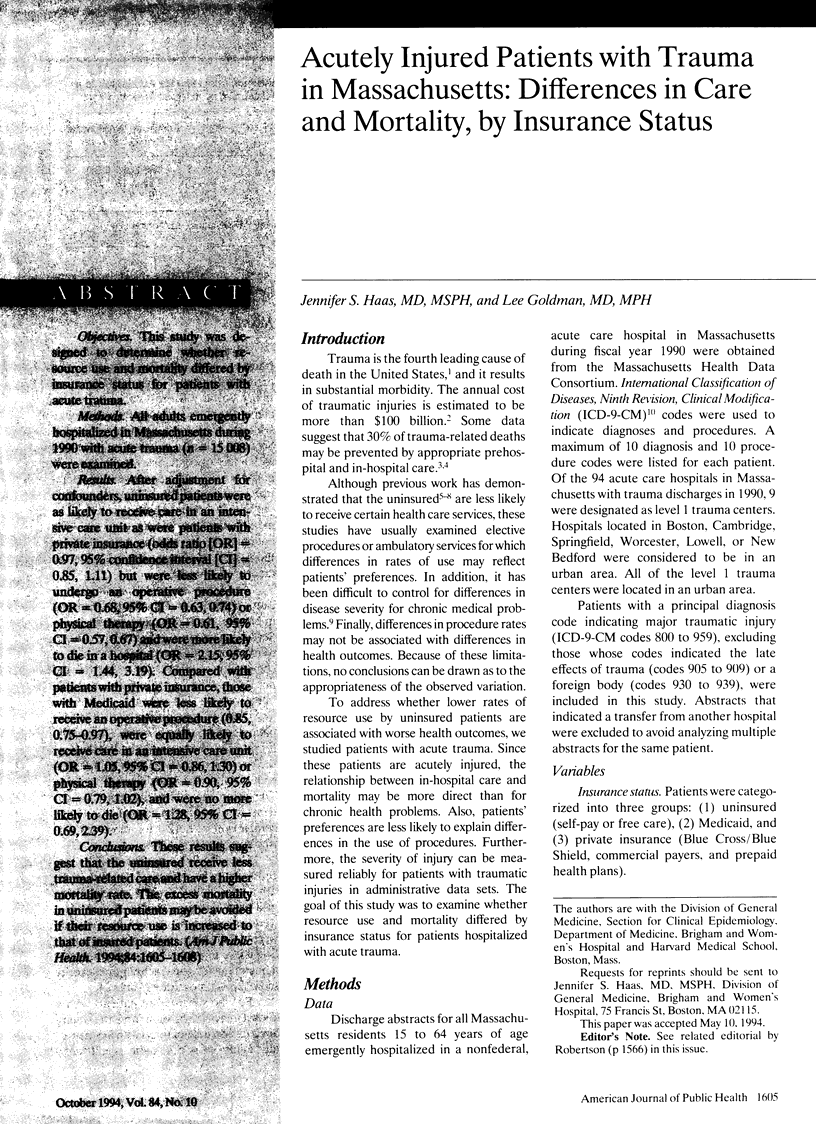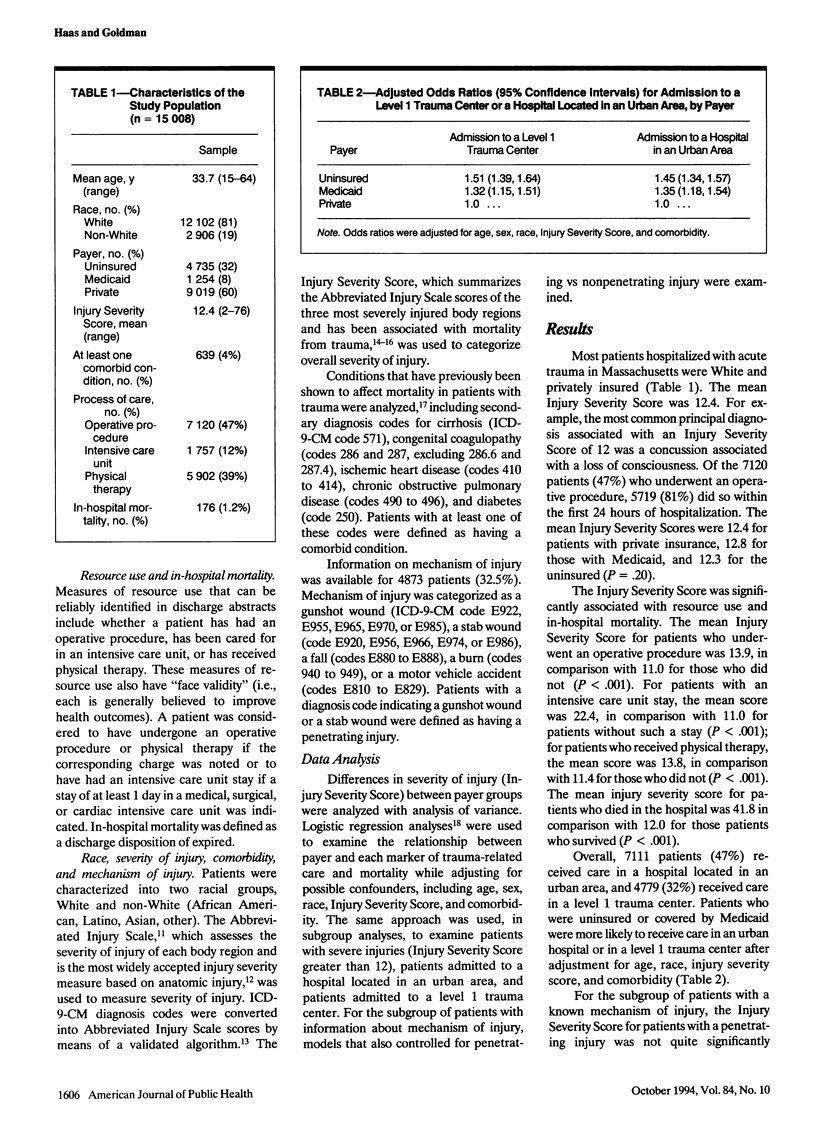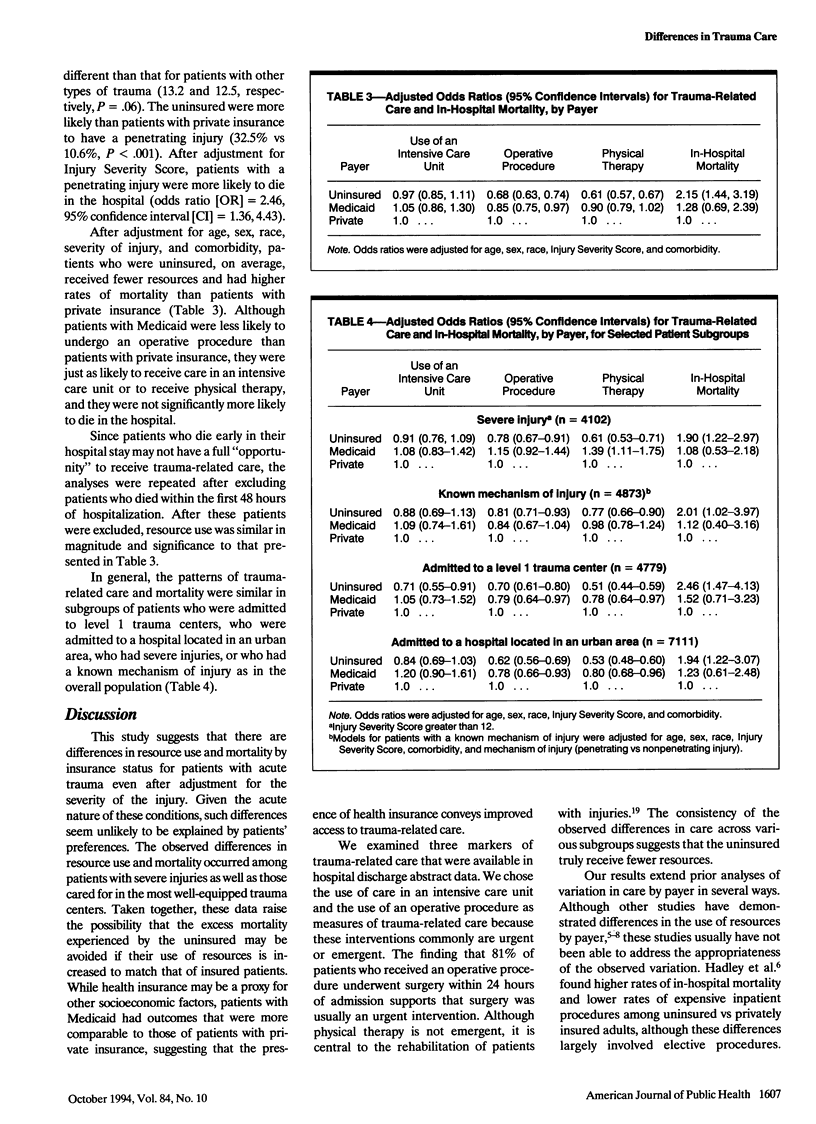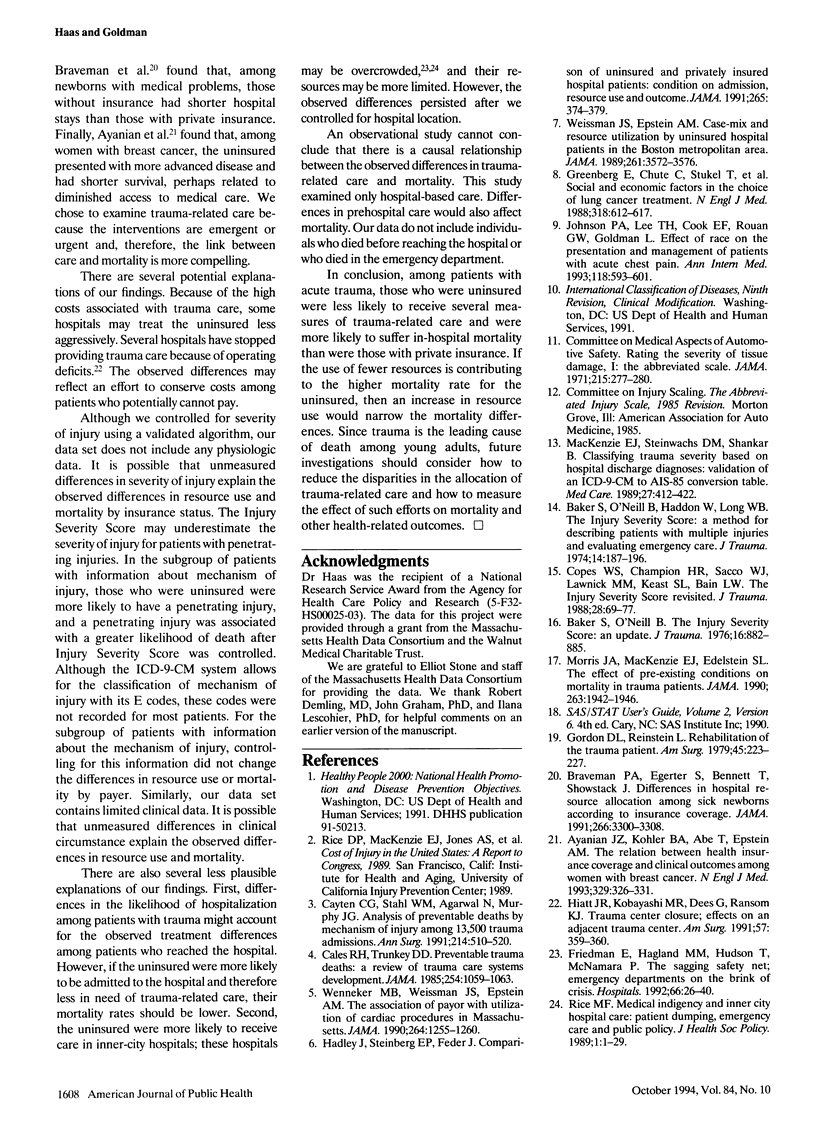Abstract
OBJECTIVES. This study was designed to determine whether resource use and mortality differed by insurance status for patients with acute trauma. METHODS. All adults emergently hospitalized in Massachusetts during 1990 with acute trauma (n = 15,008) were examined. RESULTS. After adjustment for confounders, uninsured patients were as likely to receive care in an intensive care unit as were patients with private insurance (odds ratio [OR] = 0.97, 95% confidence interval [CI] = 0.85, 1.11) but were less likely to undergo an operative procedure (OR = 0.68, 95% CI = 0.63, 0.74) or physical therapy (OR = 0.61, 95% CI = 0.57,0.67) and were more likely to die in a hospital (OR = 2.15, 95% CI = 1.44, 3.19). Compared with patients with private insurance, those with Medicaid were less likely to receive an operative procedure (0.85, 0.75-0.97), were equally likely to receive care in an intensive care unit (OR = 1.05, 95% CI = 0.86, 1.30) or physical therapy (OR = 0.90, 95% CI = 0.79, 1.02), and were no more likely to die (OR = 1.28, 95% CI = 0.69,2.39). CONCLUSIONS. These results suggest that the uninsured receive less trauma-related care and have a higher mortality rate. The excess mortality in uninsured patients may be avoided if their resource use is increased to that of insured patients.
Full text
PDF



Selected References
These references are in PubMed. This may not be the complete list of references from this article.
- Ayanian J. Z., Kohler B. A., Abe T., Epstein A. M. The relation between health insurance coverage and clinical outcomes among women with breast cancer. N Engl J Med. 1993 Jul 29;329(5):326–331. doi: 10.1056/NEJM199307293290507. [DOI] [PubMed] [Google Scholar]
- Baker S. P., O'Neill B., Haddon W., Jr, Long W. B. The injury severity score: a method for describing patients with multiple injuries and evaluating emergency care. J Trauma. 1974 Mar;14(3):187–196. [PubMed] [Google Scholar]
- Baker S. P., O'Neill B. The injury severity score: an update. J Trauma. 1976 Nov;16(11):882–885. doi: 10.1097/00005373-197611000-00006. [DOI] [PubMed] [Google Scholar]
- Braveman P. A., Egerter S., Bennett T., Showstack J. Differences in hospital resource allocation among sick newborns according to insurance coverage. JAMA. 1991 Dec 18;266(23):3300–3308. [PubMed] [Google Scholar]
- Cales R. H., Trunkey D. D. Preventable trauma deaths. A review of trauma care systems development. JAMA. 1985 Aug 23;254(8):1059–1063. doi: 10.1001/jama.254.8.1059. [DOI] [PubMed] [Google Scholar]
- Cayten C. G., Stahl W. M., Agarwal N., Murphy J. G. Analyses of preventable deaths by mechanism of injury among 13,500 trauma admissions. Ann Surg. 1991 Oct;214(4):510–521. doi: 10.1097/00000658-199110000-00015. [DOI] [PMC free article] [PubMed] [Google Scholar]
- Copes W. S., Champion H. R., Sacco W. J., Lawnick M. M., Keast S. L., Bain L. W. The Injury Severity Score revisited. J Trauma. 1988 Jan;28(1):69–77. doi: 10.1097/00005373-198801000-00010. [DOI] [PubMed] [Google Scholar]
- Friedman E., Hagland M. M., Hudson T., McNamara P. The sagging safety net. Emergency departments on the brink of crisis. Hospitals. 1992 Feb 20;66(4):26–40. [PubMed] [Google Scholar]
- Gordon D. L., Reinstein L. Rehabilitation of the trauma patient. Am Surg. 1979 Apr;45(4):223–227. [PubMed] [Google Scholar]
- Greenberg E. R., Chute C. G., Stukel T., Baron J. A., Freeman D. H., Yates J., Korson R. Social and economic factors in the choice of lung cancer treatment. A population-based study in two rural states. N Engl J Med. 1988 Mar 10;318(10):612–617. doi: 10.1056/NEJM198803103181006. [DOI] [PubMed] [Google Scholar]
- Hadley J., Steinberg E. P., Feder J. Comparison of uninsured and privately insured hospital patients. Condition on admission, resource use, and outcome. JAMA. 1991 Jan 16;265(3):374–379. [PubMed] [Google Scholar]
- Hiatt J. R., Kobayashi M. R., Dees G., Ransom K. J. Trauma center closure: effects on an adjacent trauma center. Am Surg. 1991 Jun;57(6):359–360. [PubMed] [Google Scholar]
- Johnson P. A., Lee T. H., Cook E. F., Rouan G. W., Goldman L. Effect of race on the presentation and management of patients with acute chest pain. Ann Intern Med. 1993 Apr 15;118(8):593–601. doi: 10.7326/0003-4819-118-8-199304150-00004. [DOI] [PubMed] [Google Scholar]
- MacKenzie E. J., Steinwachs D. M., Shankar B. Classifying trauma severity based on hospital discharge diagnoses. Validation of an ICD-9CM to AIS-85 conversion table. Med Care. 1989 Apr;27(4):412–422. doi: 10.1097/00005650-198904000-00008. [DOI] [PubMed] [Google Scholar]
- Morris J. A., Jr, MacKenzie E. J., Edelstein S. L. The effect of preexisting conditions on mortality in trauma patients. JAMA. 1990 Apr 11;263(14):1942–1946. [PubMed] [Google Scholar]
- Rice M. F. Medical indigency and inner city hospital care: patient dumping, emergency care and public policy. J Health Soc Policy. 1989;1(2):1–29. doi: 10.1300/j045v01n02_01. [DOI] [PubMed] [Google Scholar]
- Weissman J., Epstein A. M. Case mix and resource utilization by uninsured hospital patients in the Boston metropolitan area. JAMA. 1989 Jun 23;261(24):3572–3576. [PubMed] [Google Scholar]
- Wenneker M. B., Weissman J. S., Epstein A. M. The association of payer with utilization of cardiac procedures in Massachusetts. JAMA. 1990 Sep 12;264(10):1255–1260. [PubMed] [Google Scholar]


